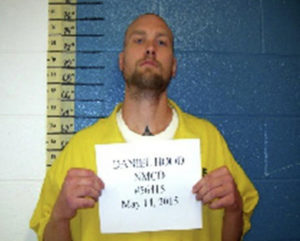- Suspect: Daniel Hood
- Victim: Frank Pauline
- Charges: Second-degree murder, possession of a deadly weapon by a prisoner
- Status: Guilty plea to second-degree murder, possession of a deadly weapon by a prisoner
- Sentence: 15 years
- Date of incident: April 27, 2015
- Agency: State Police
- Location: Southern New Mexico Correctional Facility, Las Cruces
- Magistrate case number: M-14-FR-2015-00352 (File destroyed)
- District case number: D-307-CR-2015-00523
Summary
On April 27, 2015, Daniel Hood, serving time for another murder, attacked and killed Frank Pauline by beating him three times in the back of the head with a rock while they were all out in the recreation yard at the Southern New Mexico Correctional Facility in Las Cruces.
Pauline was transferred to New Mexico from Hawaii in 2012, where he was serving a sentence for the rape and killing of a woman in 1996.
Despite that conviction, the Hawaii Innocence Project was looking into his conviction and who the DNA found on the victim in that case belonged to, thanks to new technologies.
Hood himself was serving a 180 year sentence for first and second degree murder from two killings in 1996 in Minnesota.
District Judge Fernando Macias sentenced Hood to the maximum under the plea deal, 15 years, that he must serve after finishing out his 180-year Minnesota sentence.
The incident
Daniel Hood had a plan. He was going to hit his fellow inmate, Frank Pauline, in the back of the head with a rock, either severely injuring him or killing him, according to court documents.

Hood thought Pauline knew things that were going on, had information and that the tension with him had been building up for months, State Police Investigations Bureau Agent N. Alvarado wrote in a statement of probable cause for Hood’s arrest.
State Police Sgt. Chad Pierce, the Department’s spokesman, wrote in a press release that Hood’s motivations were based on Hood’s behavior.
“Mr. Hood claimed he killed Mr. Pauline because he thought Pauline was a snitch and he walked around like he owned the place,” Pierce wrote.
On April 27, 2015, he decided to move forward with the attack, Alvarado wrote, based on his interview with Hood. The interview, on May 7, 2015, lasted 43 minutes.
Hood was handcuffed during the interview, which led to his attorney filing a motion to suppress because Hood was not read his Miranda rights before the interview. That motion was dismissed by the judge and no appeal was filed.
At some point, prison guards search Hood’s cell and found blood on his shoes and his sweatshirt top.
“Mr. Hood said that he went out there with a plan,” Alvarado wrote. “As soon as he went out to the yard, he got a rock and placed it by the cement slab. Mr. Hood said that he waited.”
Hood waited for the shift change so there were only two guards in the area.
“Mr. Hood stated after he saw the correctional officers conduct their perimeter check, he looked for Mr. Pauline,” Alvarado wrote.
Hood found Pauline walking laps around the recreational yard. There were a lot of people around him, what he wanted.
“Mr. Hood stated he expected to be caught, but he did not want to make a scene and he did not want this to become a fight,” Alvarado wrote. “Mr. Hood stated he waited until Mr. Pauline was talking to other people that way he was not paying attention as he would be distracted.”
Hood told Alvarado it took him half a lap to catch up to Pauline, because he was walking fast.
“Mr. Hood said his intention was to come up behind him and hit him in the side of the head,” Alvarado wrote. “Mr. Hood stated Mr. Pauline was walking right around the light post when he hit him. Mr. Hood said Mr. Pauline dropped straight forward.”
Hood hit him twice more in the back of the head, threw the rock and kept on walking.
Hood told Alvarado that he had grabbed the rock from west side of the yard.
“Mr. Pauline said he took his green shirt off and wrapped the rock in it,” Alvarado wrote. “Mr. Hood stated the first hit made contact in the back of Mr. Pauline’s head. Mr. Hood stated he thinks Pauline was dead when he hit the ground. He then hit him twice more.”
His sole intention was complete.
“Mr. Hood added that he did not want Mr. Pauline to walk the line again,” Alvarado wrote.
Even after killing Pauline, he walked another full lap, passing the corpse.
“Mr. Hood said the whole purpose of this attack was to prevent Mr. Pauline from defending himself or fighting,” Alvarado wrote.
Hood told Alvarado that he did not hit Pauline as hard as he could because he did not want the blood to splatter.
“Mr. Hood recalls that when he hit Mr. Pauline, he saw Mr. Pauline’s head crack,” Alvarado wrote.
Another man, William Gentry Mater, was implicated in the killing but never charged.
A guard in the jail listened to Mater’s phone calls and heard him call an unidentified woman and ask her to look up Pauline on Google and he would call her back to see what she was able to find out.
“The unidentified female tells him that Mr. Pauline had several criminal charges when he was a minor,” Alvarado wrote. “She proceeds to tell Mr. Mater that Mr. Pauline also had charges for murdering and raping a 23 year old female. At this time Mr. Mater tell the female that those charges are bad.”
Daniel Hood - Affidavit for arrest warrant - 5-14-2015
Past crimes
Frank Pauline’s past
Frank Pauline was serving a sentence for the 1991 rape and killing of Dana Ireland in Hawaii, according to news reports.
He was transferred to New Mexico in 2012 and his death was covered extensively in Hawaii.
Just days before Hood killed him, the Hawaii Innocence Project announced that DNA evidence in the old case could point to a different attacker than the three men sent to prison.
Daniel Hood’s past murder conviction
According to the supplemental criminal information filed on June 29, 2015 in Hood’s case, he was convicted of murder on July 10, 1998 in Kandiyohi County, Minn. for killing two people on Oct. 30, 1996.
According to the West Central Tribune in Willmar, Minn., Hood killed Bruce Johnson, 51, and Grace Christiansen, 81, from New London, Minn. He is serving a 180 year sentence.
Court proceedings
Motion to suppress
Hood’s attorney, Mario Esparza, wrote in his Nov. 23, 2015 motion to suppress his client’s interview with Alvarado.
Hood was never read his Miranda rights, and was therefore unable to waive them. He was also handcuffed while talking to the two agents conducting the interview, Esparza wrote.
Esparza argued this was a custodial interrogation. To admit a custodial interview at trial, the defendant has to be advised of his Miranda rights, as decided in State v. Verdugo, 2007- NMCA-095, 142 N.M. 267, State v. Salazar, 1997-NMCA-044, 123 N.M. 778 and Miranda v. Arizona, 384 U.S. 436 (1996).
Further, the burden of proof that the Miranda rights were read is on the state, he wrote.
“The New Mexico Court of Appeals has found ‘unless or until such warnings and waiver are demonstrated by the prosecution at trial, no evidence obtained as a result of interrogation can be used against [the defendant],'” Esparza wrote.
The crux of Esparza’s argument was that Hood was “in custody” when he was interviewed. If someone is not “in custody” or arrested, that is, if someone can voluntarily leave, officers do not have to read the Miranda rights.
“Defendant was serving a life sentence in Southern New Mexico Correctional Facility,” Esparza wrote. “Defendant was handcuffed during the interrogation. Defendant was ordered to remove himself from his cell and speak with individuals who wanted to speak with him. Based on the totality of the circumstances here, Defendant was in custody for purposes of Miranda.”
Prosecutor Cynthia Clark wrote in a response that Hood requested to speak with the State Police agents.
Clark cited State v. Lopez, 2000-NMCA-069, 129 N.M. 352, 8 P.3d 154, where the New Mexico Court of Appeals decided that when it comes to the rights of prisoners, to decide if they are in a custodial interrogation depends on what additional restrains to their freedom of movement have been implemented.
“The court in Lopez did not find that handcuffing the suspect or interviewing in an office to be an ‘appreciable measure of pressure or
coercion beyond the usual prison environment,” Clark wrote. “See Conley, 779 F.2d at 973-94 (handcuffs were standard procedure for transporting inmates)’ Id at, 10. Similar to the facts in Lopez, the defendant was handcuffed and transported to an office at the prison, which is customary procedure in a correctional facility.”
In addition, Alvarado did not threaten or cajole Hood.
“Thus, based on the totality of the circumstances, the defendant was not subjected to any additional pressure of a kind and intensity that would render subsequent statements by the defendant to be the product of unfair coercion,” Clark wrote. “Therefore, the defendant was not in custodial interrogation under which Miranda warnings were required and his statements to Agent Alvarado were not tainted and thus, do not require suppression.”
District Judge Fernando Macias wrote in his order denying the motion to suppress that Hood was not in custody for purposes of his Miranda rights because the shackles he was in were normal for a prisoner at his threat level and that the room they were in was not cramped.
“On balance, and in view of the totality of the circumstances, the hearing evidence did not establish that Defendant was questioned in a custodial setting for Miranda purposes,” Macias wrote. “Where either the “custody” or ‘interrogation’ prong is absent, the cautionary warnings formulated in Miranda are not required.”
Daniel Hood - Motion to supress
The plea and sentence

On Jan. 18, 2017, Hood pleaded guilty to second-degree murder and possession of a deadly weapon by a prisoner, both second-degree felonies, although second-degree murder carries a higher penalty of 15 years in prison to possession’s nine years.
According to the plea, whatever sentence he received for both charges would run concurrent to each other, that is, they would both be served at the same time, but they would be served consecutive to Hood’s sentence in the 1996 murder.
That meant Hood would have to be eligible for release on the 1996 murder conviction before he would begin to serve the second-degree murder and possession of a deadly weapon charges.
Following the plea, Macias sentenced Hood to the maximum: 15 years in prison.
Because he is already serving a 180 year sentence, whatever sentence Macias gave him means almost nothing.
Daniel Hood - REPEAT OFFENDER PLEA AND DISPOSITION AGREEMENT_Redacted
Daniel Hood - Judgement Redacted
See the case files on Google Drive or Document Cloud
Listen to the case interviews on Youtube:
For more on this and other cases, see the following links:
https://www.abqjournal.com/587428/new-evidence-could-clear-convict-ndash-too-late.html